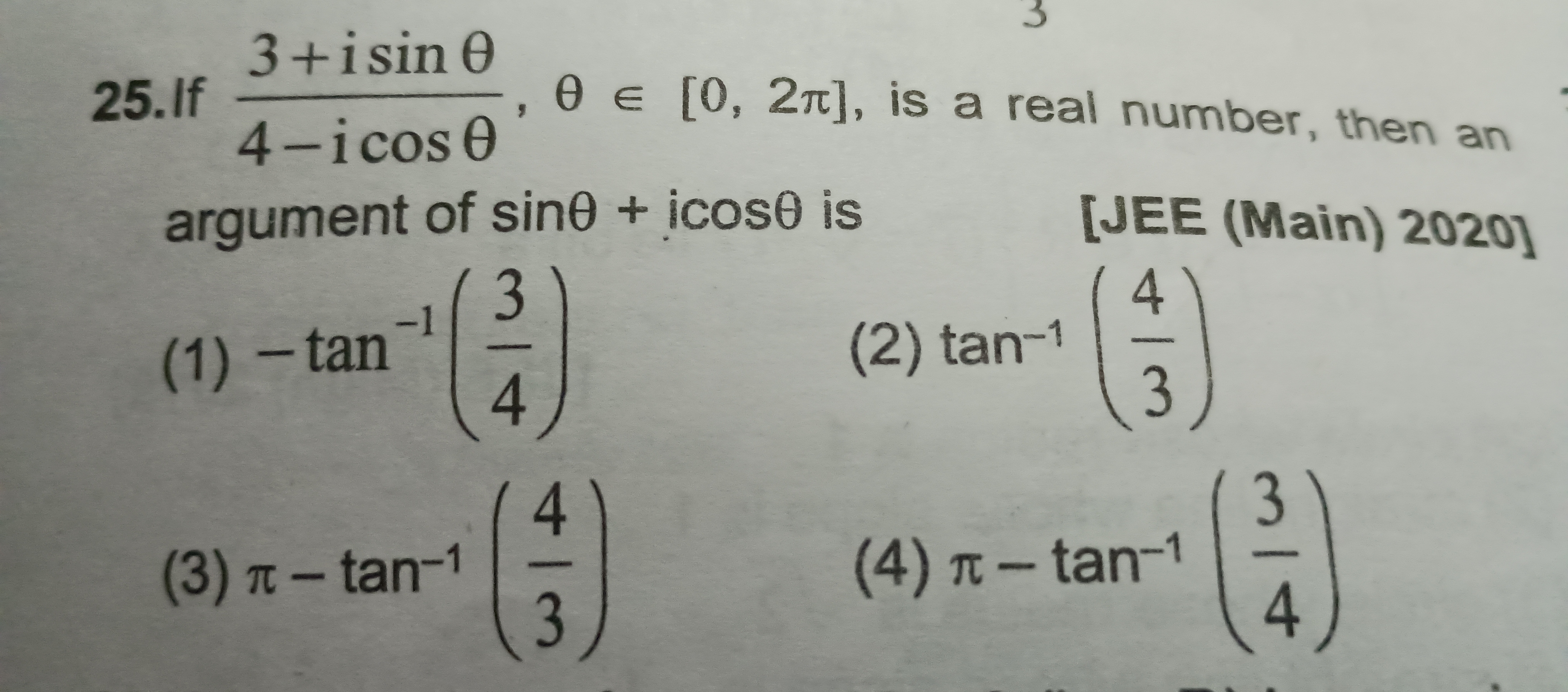Question
Question: If $\frac{3+i\sin\theta}{4-i\cos\theta}$, $\theta \in [0, 2\pi]$, is a real number, then an argument...
If 4−icosθ3+isinθ, θ∈[0,2π], is a real number, then an argument of sinθ+icosθ is

−tan−1(43)
tan−1(34)
π−tan−1(34)
π−tan−1(43)
π−tan−1(34)
Solution
Let the given complex number be Z=4−icosθ3+isinθ. For Z to be a real number, its imaginary part must be zero. We find the imaginary part by rationalizing the denominator: Z=4−icosθ3+isinθ×4+icosθ4+icosθ The numerator is: (3+isinθ)(4+icosθ)=12+3icosθ+4isinθ+i2sinθcosθ =12+i(3cosθ+4sinθ)−sinθcosθ =(12−sinθcosθ)+i(3cosθ+4sinθ) The denominator is: (4−icosθ)(4+icosθ)=42−(icosθ)2=16−i2cos2θ=16+cos2θ So, Z=16+cos2θ(12−sinθcosθ)+i(3cosθ+4sinθ). The imaginary part of Z is Im(Z)=16+cos2θ3cosθ+4sinθ. Since Z is real, Im(Z)=0. As 16+cos2θ>0, we must have: 3cosθ+4sinθ=0 4sinθ=−3cosθ Dividing by cosθ (note that cosθ=0, otherwise sinθ=0, which is impossible), we get: tanθ=−43 We are looking for an argument of the complex number w=sinθ+icosθ. Let ϕ be an argument of w. Then tanϕ=Re(w)Im(w)=sinθcosθ=cotθ. Since tanθ=−3/4, we have cotθ=tanθ1=−3/41=−34. So, tanϕ=−4/3.
The condition tanθ=−3/4 implies that θ lies in the second or fourth quadrant, since θ∈[0,2π].
Case 1: θ is in the second quadrant. In this case, sinθ>0 and cosθ<0. From tanθ=−3/4, we can construct a right triangle with opposite side 3 and adjacent side 4. The hypotenuse is 32+42=5. So, sinθ=3/5 and cosθ=−4/5. Then w=sinθ+icosθ=53+i(−54)=53−i54. This complex number is in the fourth quadrant. Its principal argument is: ϕ=arctan(3/5−4/5)=arctan(−34)=−arctan(34)
Case 2: θ is in the fourth quadrant. In this case, sinθ<0 and cosθ>0. So, sinθ=−3/5 and cosθ=4/5. Then w=sinθ+icosθ=−53+i(54)=−53+i54. This complex number is in the second quadrant. Its principal argument is: ϕ=π+arctan(−3/54/5)=π+arctan(−34)=π−arctan(34)
The possible arguments are −arctan(4/3) and π−arctan(4/3). Option (3) matches one of the possible arguments.
